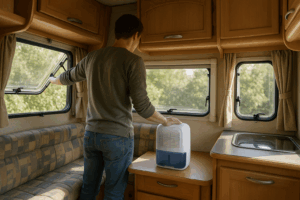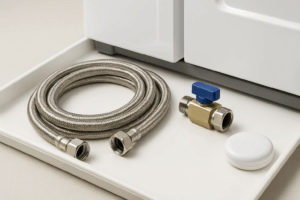If you have a fridge with an ice maker or water dispenser, you have a tiny water line hiding behind that stainless box. When that line gets tired, kinked, or chewed by time, your kitchen floor becomes a slip and slide your insurance adjuster did not ask for. This guide shows you how to spot early warning signs, upgrade to burst resistant parts, add smart leak sensors, and act fast if water shows up where it should not. Want the quick version first? Jump to the fridge leak prevention checklist and save yourself a weekend of tearing out soggy baseboards.
Why fridge leaks are dangerous
Refrigerator water line leaks rarely announce themselves with a dramatic geyser. They usually start as a slow weep that runs along your wall, under your floors, and into your baseboards. That sneaky trick is what causes the real damage. Wood swells, laminates bubble, subfloor starts to soften, and cabinets wick water from the bottom up. The longer the drip continues, the higher the chances of needing real mitigation work.
There is also the mold problem. A slow leak behind the fridge creates a dark, warm, dusty pocket that mold treats like a spa day. If you want a quick tour of where growth loves to hide, check our guide to hidden mold behind appliances. The short version is simple. A few days of hidden moisture behind a fridge can produce odor, staining, and spore activity you do not want in your kitchen.
Insurance can help with sudden and accidental water damage, but carriers ask questions. Was the line old and cracked. Was the valve stuck open. How long did it leak. Fast action gives you cleaner answers and less damage. Prevention gives you the best odds of avoiding that conversation altogether.
Early signs of a hidden leak
You do not need X ray vision. Use your nose, your fingers, and a flashlight. Slide a thin piece of cardboard under the front edge of the fridge and pull it back. If it comes out damp or gritty, something is up. Look for these clues around the fridge and adjoining cabinets.
Musty smell when you open the freezer or when the compressor kicks on. The fan can stir up humid air trapped behind the unit.
Edges of planks cupping near the toe kick. Laminate and wood floors will warp along the boards near the fridge first.
Discoloration or swelling along baseboard corners next to the fridge wall. Light tan staining is a common early tell.
Water spots under the fridge when you slide it forward a few inches. If you see dust bunnies matted together, they got wet at some point.
Ice maker misfires or longer than usual fill cycles. If the valve is partially clogged, it can hint at mineral buildup or a kinked line that is stressing the system.
Ants. Yes, really. They like moisture and sugars. If you see an ant parade along the back wall near your fridge, check for dampness.
Even one of these is worth a closer look. If you already upgraded the line and fittings, that is great. If not, keep reading. Refrigerator water line leak prevention is easier and cheaper than replacing floors.
Prevention upgrades that work
Think of this section as a mini makeover for the most ignored part of your kitchen. You do not need a full remodel. A few targeted upgrades cut risk dramatically and make life easier when it is time to clean or service the fridge.
Swap brittle tubing for braided line
Many fridges still run on thin plastic tubing that gets stiff, cracks at bends, or kinks when you move the unit. Replace that with a braided stainless steel hose or a braided PEX or PVC core line. The braided jacket resists abrasion and helps prevent a sudden split. Retail models even ship with internal burst protection that limits flow if a rupture happens. A good example is the Burst Protect stainless ice maker supply line you can find at retailers such as Home Depot.
Tips for swapping the line like a pro without the boots. Measure twice. Leave a gentle loop of slack, not a tight coil. Avoid any sharp edge where the line passes through a cabinet or wall. Use a grommet or a short piece of plastic tubing as a sleeve at that pass through point. Hand tighten the compression fitting, then a quarter turn with a wrench. Do not muscle it. Run a dry paper towel around both fittings while the water is on to check for weeping. If the towel stays dry, you are golden.
Install a shutoff you can reach
Many kitchens hide the fridge shutoff valve down behind the unit where only contortionists can reach it. Add a small needle valve or service box where you can reach it without moving the fridge. That way, if something fails, you can stop the water in seconds. See a typical built in water line kit with valve body and fittings similar to the Smart Choice kit shown at Best Buy.
Placement options. Inside the adjacent sink base. In the basement or crawl directly below, mounted up high. Inside a shallow recess box in the wall if you are renovating. Label the valve clearly, then show your family where it is, because leaks do not wait until you get home.
Add an automatic fridge leak shutoff valve
If you travel often or just want peace of mind, add a device that closes the water supply when a sensor detects moisture or when water flow goes way beyond what an ice maker needs. You have three basic approaches.
Point of use electronic shutoff. These pairs a small valve with a leak sensor that sits on the floor or under the fridge pan. If it senses water, it shuts the valve and can even send an alert. A popular appliance example is the Watts IntelliFlow series used on washing machines. The same technology is available for other appliances and can be adapted by a plumber for fridge duty. You can view this style of device at retailmarket.net.
Mechanical flow limiter. This is a no power option that shuts off water when continuous flow exceeds a preset volume. Think of it as a seat belt for your water line. It reacts to an abnormal run time instead of electricity or Wi Fi. WaterBlock style devices are a good example and you can see them at Water Damage Defense.
Whole home smart valve. If you want your alarm panel or smart hub to close the main water line when any sensor triggers, look at systems like the IQ Water Valve from Qolsys. Tie a puck sensor or rope sensor behind the fridge to your panel, and if it gets wet, the main valve closes and your phone lights up. That setup is described at Securu.
Not sure where to start. We wrote a practical guide to prevent water damage that includes quick wins like appliance checks, drip trays, and sensor placement. Even a simple five dollar plastic tray under the fridge can buy you time and keep a small leak from spreading across the room.
Route it right and protect the line
Most leaks start at pinch points or tired fittings. Keep the line off the floor with a few adhesive clamps along the back wall. Skip tight bends. If you must turn sharply, use a gentle loop or a ninety degree elbow designed for the job. Make sure the fridge rollers do not sit directly on the line after you push the unit back. Tape is not a clamp. Use real clamps or brackets that will not slip under vibration.
Set a simple maintenance cycle
A little attention twice a year keeps surprises at bay. Pull the kick plate, vacuum the dust from the condenser area, and check for any moisture. Run your fingers along the water line and fittings to feel for dampness or mineral crust. Plastic lines have a short life, often five to ten years. Braided lines last longer, but nothing is forever. Replace any line that looks scarred, yellowed, or stiff. Any time the fridge is moved, take an extra minute to check the compression nut and ferrule at both ends. If you see a drip, replace the ferrule and re make the connection. That tiny ring of soft metal is cheap insurance.
Smart sensors and home integration
Smart sensors are the fire alarm for your water line. A small puck or rope sensor lives behind or under the fridge. If it detects water, it chirps, flashes, and texts you. If you link that alert to a valve, the water shuts off automatically. No drama and less damage. The best part is you can also trigger automations like ping your family chat, pause the ice maker, or flash a light in the kitchen to get attention.
Placement matters. Put a small pan under the fridge and set a sensor in the pan. Tuck a rope sensor along the wall where the line runs so it will catch a slow weep that hugs the baseboard. If your fridge sits over a finished basement, add a sensor to the ceiling under that spot for backup.
We break down options and smart home pairings in our guide to smart water management. Whether you are a Wi Fi only household or you run a full alarm panel, there is a simple setup that will yell at you the second water touches that sensor.
Immediate steps if you spot a leak
Act fast, stay safe, then call in backup if things get soggy. Here is what we tell our own families to do when they see water around the fridge.
Shut off the water to the fridge. If you installed a reachable valve at the sink base or in a nearby cabinet, close it. If you cannot find it or it is stuck, close the main water line to the house. For a quick refresher on the fastest way to do that safely, read our guide on how to turn off the water supply.
Unplug the fridge if water has reached any outlet or cord. Water and electricity are a terrible combo. If you need to cross standing water to reach the plug or breaker, wait for help.
Contain the water with towels, a mop, and a bucket. A wet dry vac is your best friend here. Get the easy water up quickly so it does not migrate into other rooms or down through the subfloor. Keep an eye on the seams between flooring planks and around the toe kicks. Those are the paths water loves.
Promote airflow. Crack a window, set a box fan to blow air along the baseboard, open the cabinet doors near the fridge, and pull the kick plate to let air under the unit. If you have a dehumidifier, run it.
If more than a few square feet of flooring is wet, the water ran under cabinets, or you see water dripping into a level below, it is time to call in the cavalry. We offer 24 and 7 emergency water extraction and can get the area dry fast before mold or odors kick in.
Cost and insurance basics
Preventive gear is cheap compared to floors and cabinets. A braided refrigerator water line usually runs between ten and thirty dollars. A reachable needle valve or service box kit ranges from twenty to fifty dollars. A plumber can install both pieces in roughly an hour or two, so plan for labor in the low hundreds in many markets. Electronic point of use shutoff devices range widely by brand and features. Mechanical flow limiters usually cost less than the electronic options. Smart leak sensors are often under sixty dollars per sensor and can be added gradually.
If a leak has already damaged flooring or cabinets, costs rise with square footage and materials. For ballpark guidance, see our page on water damage repair cost. Insurance may cover sudden and accidental water events, but deductibles apply and wear and tear items are usually on the homeowner. Document what you see with photos, note the time you found it, and keep any damaged parts. Your adjuster will thank you for being organized.
Quick checklist and CTA
Want a no nonsense checklist you can knock out in fifteen minutes. This is the short list our team uses in the field for refrigerator water line leak prevention.
- Inspect the water line and fittings, then feel for dampness along the full length.
- Replace any thin plastic tubing with a braided stainless or braided PEX line with internal burst protection.
- Add a reachable shutoff valve and label it.
- Place a drip tray under the fridge and put a leak sensor in the tray.
- Secure the line off the floor, avoid kinks, and sleeve it through any cabinet holes.
- Test your sensor and any automatic valve at least once a year.
See something wet right now. Call for rapid response and emergency water extraction. The faster we get there, the less you will need to repair.
Frequently asked questions
What causes refrigerator water lines to leak?
Age, abrasion against the wall or cabinet, kinking during delivery or cleaning, over tightened or under tightened compression fittings, mineral buildup in valves, and brittle plastic tubing are the usual suspects. Upgrading to a braided supply line with burst protection reduces rupture risk. See a representative braided product example at Home Depot.
How often should I replace my fridge water line?
Plastic lines age out faster. Many homeowners replace them every five to ten years or sooner if there is any discoloration, stiffness, or visible wear. Braided lines last longer, but a ten year swap is a safe target unless you see damage. If you move the fridge often, inspect more frequently. A common kit style is shown at Best Buy.
Can a small leak behind the fridge cause mold?
Yes. Even a slow weep can feed growth behind the unit where air does not circulate. That can spread odor and allergen issues into the kitchen. If you suspect it, start with our quick guide to hidden mold behind appliances and call for a moisture check if needed.
What should I do first if my fridge water line bursts?
Close the fridge shutoff valve or the main water line immediately. Unplug the fridge if water is contacting any outlet or the cord. Contain the water with towels and a wet dry vac. Ventilate the area. Then call for emergency water extraction so the area can be dried properly. For a refresher on quick actions, keep this page handy on how to turn off the water supply.
Are automatic shutoff valves worth it?
If you travel often, own a rental, or just want your phone to tattletale when water shows up, yes. Automatic valves paired with leak sensors can shut water to the fridge fast and cut losses. Examples include electronic shutoffs like the IntelliFlow concept shown here, mechanical flow limiters like WaterBlock devices here, and whole home smart valves such as the IQ Water Valve here.
Where is the fridge shutoff valve usually located?
Common spots include the cabinet next to the fridge, the basement or crawlspace directly below, or a wall box behind the unit. If you cannot find it, follow the small water line back from the fridge to where it tees off the cold line. If there is no accessible valve, ask a plumber to add one in an easy to reach spot. It is a small job that pays off if a leak starts.
What is the best type of refrigerator water line?
A braided stainless steel line or a braided PEX core line is the current favorite for most homes. These resist kinking and abrasion better than bare plastic. Look for models with internal burst protection and high quality compression fittings. Measure correctly, leave a gentle loop, and do not overtighten.
A quick word before you get back to your day
You came for refrigerator water line leak prevention, and now you have a game plan. Upgrade the line, add a reachable valve, drop a smart sensor, and consider an automatic fridge leak shutoff valve if you want the set it and forget it approach. Keep airflow moving if you see moisture, and do not ignore a funky smell from behind the fridge. If water is already pooling, we can handle the mess while you keep your sanity. When you need rapid help, tap our link for emergency water extraction and we will get your kitchen back on track fast.







